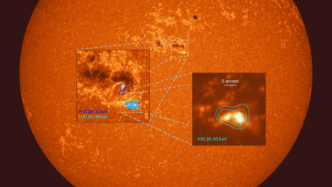
The Purple Mountain Observatory of the Chinese Academy of Sciences reported on the 29th that more than 100 solar white-light flares have been observed since the launch of the comprehensive solar exploration satellite "Kuafu-1" (ASO-S) more than a year ago. This observation far exceeds the previous expectation of the frequency of white-light flares, and has important scientific significance for space weather forecasting.
Solar white light flares are a type of flare that shows enhanced radiation in the visible light continuum. Such flares are usually high in energy, and their appearance can have an impact on space weather, such as causing ground communication failures or interruptions and interfering with the normal operation of spacecraft.
Before the launch of the Kuafu-1 satellite, humans had only observed and reported about 300 solar white light flare events, which is a very low proportion of the total number of flare eruptions.
The Kuafu-1 satellite team analyzed 205 high-energy flares that occurred from October 2022 to May 2023 and identified 49 white-light flares, with an incidence of 24%, much higher than previously observed data. With the arrival of the peak year of solar activity, more and more flares are identified as white-light flares. As of the end of December 2023, more than 120 white-light flares have been observed by the White Light Solar Telescope (WST/ASO-S) on Kuafu-1, providing samples for exploring the physical nature of white-light flares.
"The observation data from 'Kuafu-1' show that white-light flares are not as rare as people previously thought. In the next step, the satellite team will continue to combine multi-band observations from other satellites to comprehensively study white-light flares and provide a theoretical basis for my country's space weather forecast." Gan Weiqun, chief scientist of "Kuafu-1" and researcher at the Purple Mountain Observatory of the Chinese Academy of Sciences, said.
Kuafu-1 is a comprehensive solar exploration satellite in my country. It was launched on October 9, 2022 and officially delivered to the Purple Mountain Observatory of the Chinese Academy of Sciences in September 2023. It is currently in the on-orbit scientific operation stage. Since the launch of the satellite, about 600TB of raw solar observation data has been recorded, providing rich materials for subsequent research.
Relevant research results have been published in the internationally renowned journals Solar Physics and The Astrophysical Journal Letters.
